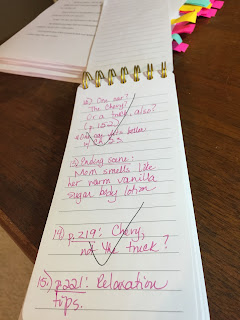Ready to take your writing to the next level? The following are some of my favorite revision tips and tricks. If you add your revision ideas in the comments box, everyone will benefit. Thanks so much, and happy revising!
REVISION IDEAS:
1. Print your manuscript in a different font and/or send it to your Kindle. Many agents and editors read on e-readers, so it's a good idea to take this step.
2. Read through your manuscript. Flag pages that require attention. (Gather plenty of sticky notes first!)
3. Make a list of what needs to be done to make the story stronger. Later, when you complete each item, check it off your list. It's amazing how satisfying this feels!
4. Quicken the pace. Add occasional one or two-word sentences. More dialogue, more action, clear goals, high stakes.
5. Look at every scene and chapter ending. Are they full of suspense?
6. Use a highlighter to mark distinctive character traits. Are they consistent throughout?
7. Read your first sentence aloud. Is there a hook that draws the reader into the story? If time allows, read your entire manuscript aloud. Record yourself reading.
8. Re-read the first chapter. Does it present an intriguing problem and a vibrant, unusual character? Does it establish character, setting, and problem?
9. Cut weak words. Some examples: Beautiful, smile, a lot, really, something, always, sort of, look, kind of, that, slowly, very, realize, suddenly, it occurred, nod, feel, stare, glance, look, laugh, suddenly, sigh.
10. Cut “ly” adverbs.
11. Cut dialogue tags. (“He said/she said” after every single line of dialogue can slow the pace.)
12. Double-check dialogue. Does each character’s dialogue fit their personality? Do they sound different from each other? Highlight each character's dialogue using a different color for each character.
13. Map the story ARC. Do the problems get bigger and bigger until you reach the worst day/scenario ever for the main character?
14. Write down the theme of your story. What has the main character learned through his/her trials and problems? How has he/she changed?
15. Read SELF-EDITING FOR FICTION WRITERS, by Renni Brown and Dave King
16. Examine each scene. Does each scene have an inciting event, conflict, and climax?
17. Identify your main character's goal. Can you easily identify what your main character wants/needs? His/her outer goal and innermost need? A lie the character believes to be true? A wound from the past?
18. Check character mannerisms. Are they consistent?
19. Vary sentence lengths. Change the rhythm of your words, if necessary. Revise like a poet!
20. Read your story ending. Does it have unexpected inevitability?




3 comments:
Great tips! (I'm big on sticky note flags, lists, and highlighters.)
All good tips. I especially like the first one. Time was when a hard copy was the only way to edit. We sometimes think we can skip this in an effort to go green, or because a manuscript is long and a hard copy seems unwieldy. I returned to printing when I beta-read, and re-discovered how pertinent editing from a hard copy still is.
Great ideas. I love the sticky note pic!
Post a Comment